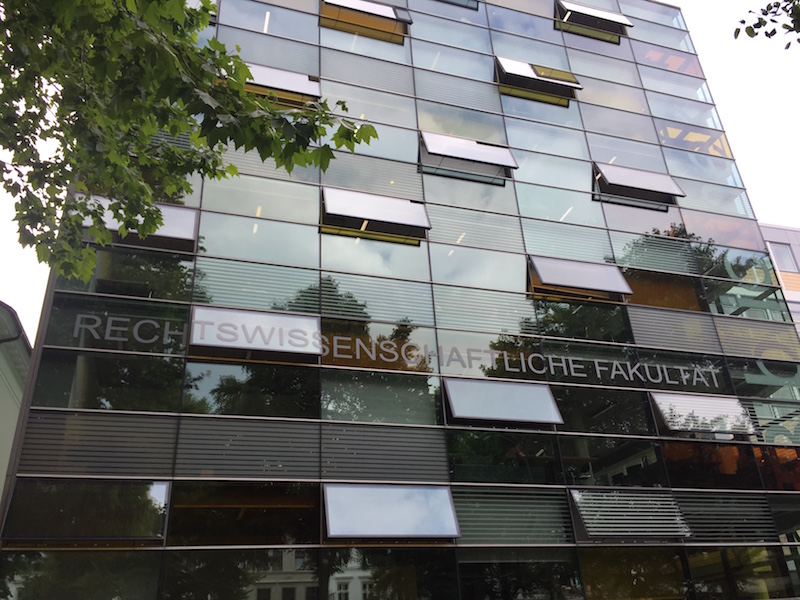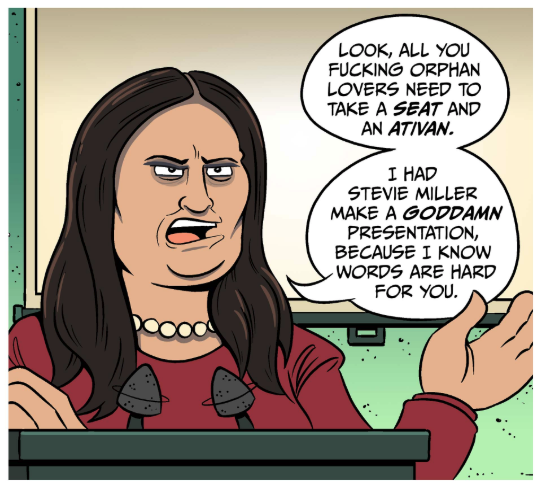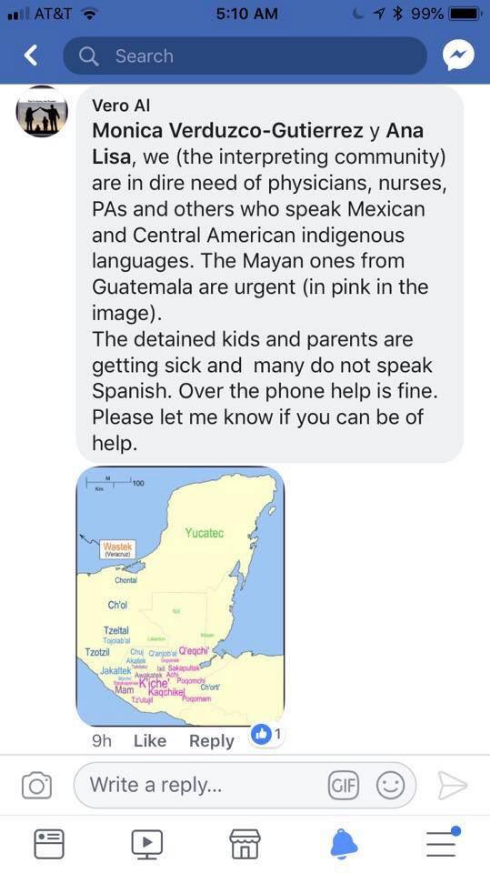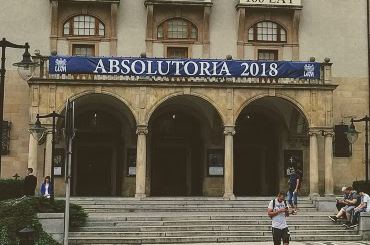June 27, 2018 @ 5:47 am
· Filed by Mark Liberman under Crash blossoms, Language and politics
Roger Lustig, commenting the headline "Paul Ryan calls on Maxine Waters to apologize" (Sunlen Serfaty and Katherine Sullivan,CNN 6/26/2018):
At first I thought he'd gone over to her house and said he was sorry.
If only.
Read the rest of this entry »
Permalink
June 26, 2018 @ 3:42 pm
· Filed by Victor Mair under Language and food, Names
Eating establishment near Baruch College in New York City:

Read the rest of this entry »
Permalink
June 25, 2018 @ 11:47 pm
· Filed by Victor Mair under Borrowing, Etymology, Lexicon and lexicography, Linguistic history, Names, Signs
I'm in Hamburg for lectures and meetings this week.
The first day I was here, in the afternoon I went out for a walk. After taking about 50 steps from the front door of my hotel, I saw this lettering on the glass facade of a nearby building:

Read the rest of this entry »
Permalink
June 25, 2018 @ 8:26 am
· Filed by Mark Liberman under Language and politics
 As background to the discussion of Melania Trump's jacket choices, Giovanni Tiso presents "A brief (fascist) history of ‘I don’t care’", Overland 6/22/2018:
As background to the discussion of Melania Trump's jacket choices, Giovanni Tiso presents "A brief (fascist) history of ‘I don’t care’", Overland 6/22/2018:
Fascism lay its roots in the campaign for Italy’s late entry in the First World War, of which Mussolini was one of the leaders. It was at this time that the phrase ‘me ne frego’ – which at the time was still considered quite vulgar, along the lines of the English ‘I don’t give a fuck’ – was sung by members of the special force known as arditi (literally: ‘the daring ones’) who volunteered for the front, to signify that they didn’t care if they should lose their lives.
The arditi were disbanded after the war, but many of them volunteered in 1919 for an expedition led by the poet Gabriele D’Annunzio to capture the city of Fiume (Rijeka, in present-day Croatia) and claim it for Italy during the vacuum created by the dissolution of the Austro-Hungarian empire. At the time of this occupation, former arditi also formed the backbone of the original Black Squads during the terror campaigns that began in 1919 and culminated with the ‘March on Rome’ of 1922, which completed Fascism’s swift rise to power. […]
Read the rest of this entry »
Permalink
June 24, 2018 @ 8:52 am
· Filed by Victor Mair under Language and sports, Names, Transcription
Article in NBC Sports (6/22/18) by Drew Shiller: "Report: Chinese prospect Abudushalamu Abudurexiti will play for Warriors in Summer League".
Quips heard around the Language Log water cooler:
Geoff Nunberg: "It’ll give the announcers something new to chew on, now that they’ve learned to toss off Giannis Antetokounmpo."
Barbara Partee: "If that article has the pronunciation anywhere near right, then I'll bet his nickname will be Budu-Budu. I like it."
For sure, it's gonna be a challenge for NBA announcers to rattle off his name, but let's see what we're really dealing with.
Read the rest of this entry »
Permalink
June 23, 2018 @ 11:57 am
· Filed by Mark Liberman under Animal communication
"Koko, the Gorilla Who Knew Sign Language, Dies at 46", Associated Press 6/21/2018:
Koko the gorilla who mastered sign language, raised kittens and once playfully tried on the glasses of the late actor Robin Williams, has died. She was 46.
The Gorilla Foundation says the western lowland gorilla died in her sleep at the foundation's preserve in California's Santa Cruz mountains on Tuesday.
Koko's capacity for language and empathy opened the minds and hearts of millions of people, the foundation said. She appeared in many documentaries and twice in National Geographic. The gorilla's 1978 cover featured a photo that the animal had taken of herself in a mirror.
Read the rest of this entry »
Permalink
June 22, 2018 @ 11:44 am
· Filed by Neal Goldfarb under Bilingualism, Language and medicine, Language and the law, Language and travel
Let me try to pull together the information from my previous two posts, and add information that I'm seeing on Twitter. I will update this as I get more information.
Service-providers looking for interpreters. Much of the interpreting that is needed can be done by phone, so geographic location shouldn't be an issue.
RAICES: volunteer@raicestexas.org.
American Immigration Council. The person to contact is Crystal Massey, but the website doesn't give her email address. The general "Contact Us" page is here. (Added June 24, 2018.)
Service-providers that might need interpreters. These are names of groups that someone posted on Twitter; I don't know whether they're actually looking for interpreters.
Read the rest of this entry »
Permalink
June 22, 2018 @ 8:45 am
· Filed by Victor Mair under Language and culture, Language and literature, Translation, Writing systems
We've been having a vigorous debate on the nature of Sinograms: "Character crises". It started on June 15, but it is still going on quite actively in the comments section. A new reader of Language Log, a scholar of late medieval Chinese literature from Beijing was prompted by her reading of this lively discussion and other LL posts to which it led her to send in the following remarks:
Thanks to your blogs, I begin to be aware of some amusing aspects of Chinese languages, though I am still struggling with the terminology.
Read the rest of this entry »
Permalink
June 22, 2018 @ 7:47 am
· Filed by Mark Liberman under Linguistics in the comics
From the first panel of the most recent Scenes From a Multiverse, an example of what Wikipedia calls "Type 2 Zeugma" or "semantic syllepsis":

Read the rest of this entry »
Permalink
June 22, 2018 @ 1:45 am
· Filed by Neal Goldfarb under Bilingualism, Language and medicine, Language and the law, Language and travel, Translation
In addition interpreters being needed to help detainees communicate with their lawyers, there is an urgent need for medical personnel who can speak Central American indigenous languages (or, failing that, presumably for interpreters to work with English- and Spanish-speaking medical personnel). This is a Facebook post that Emily Bender has sent me:

Read the rest of this entry »
Permalink
June 21, 2018 @ 6:04 pm
· Filed by Victor Mair under Intonation, Language and business, Slogans
Last week there were large scale truckers strikes in many parts of China. China watchers around the world were stunned, especially since some of the strikers were shouting out what sounded like "overthrow the Communist Party!", as at 3:48 in this video.
Here's the audio portion of the leader of one of the strikes shouting what sounds like "dǎdǎo gòngchǎndǎng 打倒共产党" ("overthrow the Communist Party") into a microphone, followed by a throng of truckers responding in unison.
Audio clip: Adobe Flash Player (version 9 or above) is required to play this audio clip. Download the latest version here. You also need to have JavaScript enabled in your browser.
Read the rest of this entry »
Permalink
June 21, 2018 @ 10:58 am
· Filed by Mark Liberman under Words words words
 When I saw a large sign reading "ABSOLUTORIA 2018" on a vaguely ecclesiastical-looking building in Poznań last week, my first ignorant thought was that maybe there was a sort of special on indulgences. But that was wrong, and so was my second thought that it might be a vodka festival.
When I saw a large sign reading "ABSOLUTORIA 2018" on a vaguely ecclesiastical-looking building in Poznań last week, my first ignorant thought was that maybe there was a sort of special on indulgences. But that was wrong, and so was my second thought that it might be a vodka festival.
A quick inspection of the building's smaller signage identified it as part of Adam Mickiewicz University, and suggested that "absolutoria" in this context means graduation ceremonies. A Polish-English dictionary confirmed this inference, and the site absolutoria.poznan.pl offers pictures.
Read the rest of this entry »
Permalink





